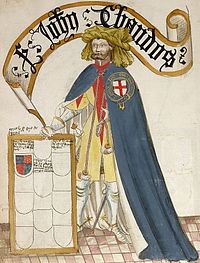



Sir John Chandos, Viscount of Saint-Sauveur in the Cotentin, Constable of Aquitaine, Seneschal of Poitou, KG (c. 1320 – 31 December 1369) was a medieval English knight who hailed from Radbourne Hall, Derbyshire. Chandos was a close friend of Edward the Black Prince and a founding member and 19th Knight of the Order of the Garter in 1348. Chandos was a gentleman by birth, but unlike most commanders of the day he held no inherited title of nobility.
Described by the medieval historian Froissart as "wise and full of devices", as a military strategist Chandos is believed to have been the mastermind behind three of the most important English victories of the Hundred Years War: the Battle of Crécy, the Battle of Poitiers and the Battle of Auray. His death in a minor skirmish was regretted by both sides.
- ^ Froissart describes Chandos's arms thus: 'Si estoit la banniere Monseigneur Jehan Camdos: d'argent a un pel aguiset de gueulles' (Oeuvres de Froissart, ed. Kervyn de Lettenhove, VII, p. 196). There are also three English rolls of arms with painted shields: Antiquaries Roll (c.1360) AN 95 'John Chandos', County Roll (temp Ric II) CY 100, CY 399 'S' John Chandos, of Staffs', and Collins's Roll II (15c.) Q II 545 'Sir John Chandos' (cited in T. Woodcock - S. Flower (edd.), Dictionary of British Arms, IV, London, 2014, p. 297). In addition, given Sir John's international fame, there are similar entries in three continental rolls, Armorial du héraut Navarre (c. 1368-1375) NAV 1481 'M Jehan Chandos', Urfé Roll (ca. 1381) URF 211 'Messire Jehan Cando, d argent a j pel de gueules esguisie', and Armorial Gelre (ca. 1385) GEL 632 'H' Jan Sandoys' (cited in s.v. 'chandos 1', in S. Clemmensen, Ordinary of Medieval Armorials, CD-ROM, rev. edn., Copenhagen, 2013). Two of these sources date from Sir John's lifetime.